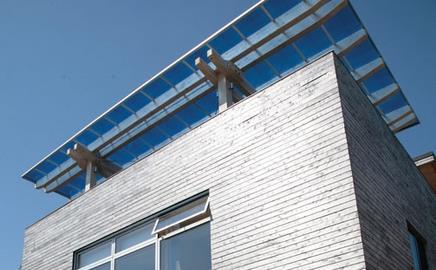Willmott Dixon has developed a prototype of a healthcare facility of the future, which includes self-diagnosis pods, robotic medicine dispensing and remote treatment
In the car park of BREŌĆÖs Innovation Park near Watford, an articulated lorry has transformed itself into a state-of-the-art operating theatre. This slightly eerie high-tech field hospital is a sign of the changing face of healthcare; a more permanent example sits a few metres away.
In the next 10 years, the NHS will undergo radical changes, including a reduction in the number of short-stay hospital patients and a shift to greater local-level care. There are three main drivers behind these changes ŌĆō the ageing population, increased patient expectations and advances in technology.
Responding to this shift, contractor Willmott Dixon and healthcare premises provider Primary Asset have created the community healthcare campus at BREŌĆÖs Innovation Park. ŌĆ£The idea is to reflect how healthcare services will evolve in the coming years and how premises will need to take into account these changes,ŌĆØ says Mike Clarke, health sector manager for Willmott Dixon.
A quick tour gives an insight into what the community healthcare centre of tomorrow might contain. Gone is the waiting room with dog-eared magazines. It is replaced with an airport-style check-in facility, information on TV screens and a self-diagnosis pod, where you can measure and register your weight, body mass index and blood pressure. The focus is as much on prevention as cure.
Alongside the waiting area sits a pharmacy with robotic dispensing and a touchscreen Healthpoint ŌĆō a computerised system where patients can get explanations of various conditions and treatments, dietary and nutritional advice and videos explaining procedures. According to Clarke, pharmacists are an untapped source of knowledge and will work increasingly in primary healthcare.
At the heart of the NHSŌĆÖ strategy, however, will be ŌĆ£assistive livingŌĆØ and telecare. Assistive living is seen as a way for primary care trusts to provide older patients with remote care in homes. The hope is that using digital information and communication systems, known as telecare, will help avoid patients making unnecessary trips to clinics.
The system can support routine diagnostics, monitoring, screening and basic counselling and advice. Sensors, for example, would enable a diabetic to check their blood sugar levels. The results would be sent to the health centre where a nurse could check them.
According to Clarke, such systems are on the market now; the problem is that there is no common language that allows equipment from different manufacturers to communicate easily. ŌĆ£Ultimately what we want is a single piece of kit that uses USB technology, which you can plug any piece of kit into.ŌĆØ
These advancements could have applications beyond healthcare. Universal USB technology would also be relevant to Willmott DixonŌĆÖs social housing arm, Inspace. ŌĆ£If there is a standard saying every new house needs this kit, it could have a massive impact on the IT specification,ŌĆØ says Clarke.
Also through Telecare, consultants would be able to watch examinations via high-definition cameras installed at the campus and give advice remotely.
From a brief tour around BREŌĆÖs park, it is clear that the future of healthcare in the UK will involve multi-functional spaces, housing rooms that can transform themselves from GPŌĆÖs consulting rooms in the morning to physiotherapy spaces in the afternoon and community resources in the evening. And it seems that future may not be too distant.
From school to community health centre

The community healthcare campus is a reworking of Willmott DixonŌĆÖs Re-Thinking School of the Future that was built in 2007. This was a carbon-neutral prototype that could be manufactured off site and used a superstructure made from cross-laminated timber panels that locked in 83 tonnes of carbon.
According to Willmott Dixon, the adaptability of the existing structure made the refurbishment relatively pain free. The structure could accommodate changes, such as new doors and window openings along with smaller alterations for services by cutting out sections of the wall.
This helped to reduce the energy consumption of the building by making it predominantly naturally ventilated, with windows, skylight and clerestories automatically set to open when temperatures or internal CO2 levels rise.

Not all areas could be naturally ventilated.
The clinical spaces need to meet the standards for air quality, which means 10 air changes an hour. A mechanical ventilation unit that uses fresh air preheated by a 30m2 solar wall cladding panel mounted on the buildingŌĆÖs south elevation was used.
The air is diffused into the space at low velocity through a long fabric duct that is treated with an anti-microbial coating. This offers minimal resistance to the air flow, enabling a low energy fan to be used which is powered by renewables.
Engineering consultant Cundall predicts the energy use of the facility would be 31.88GJ/m3/ year, which compares well with the target for a new NHS facility of 45-55GJ/m3/year.

Another challenge is infection control. Timber finishes arenŌĆÖt ideal and so most of the internal walls have been lined with plasterboard, finished with anti-microbial paints.
Clinical trials have shown that copper surfaces kill almost all MRSA pathogens and the bacterium clostridium difficile. Other measures to control infections include the use of brass cupboard handles and taps ŌĆō which allow the retention of the GP-preferred wrist and elbow lever taps rather than infra-red sensor taps ŌĆō and copper tubing for the staircase handrail.
The site also has an example of a changing facility formed from a solid spiralling wall, which avoids the need for curtains (which can be a potential source of infection) and moving parts.
Postscript
Original print headline: 'New age medicine'
Topics
Specifier 19 June 2009
- 1
- 2
- 3
- 4
- 5
- 6
- 7
- 8
 Currently reading
Currently readingNew age medicine: healthcare technology
- 9
- 10































1 Readers' comment